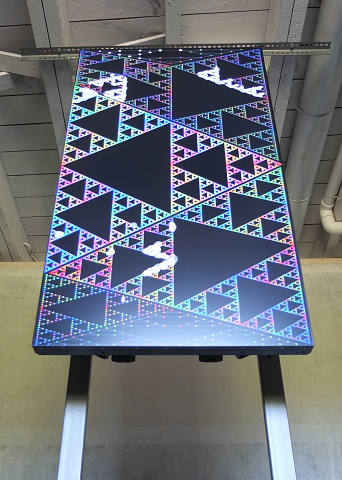
Photo Caja Maria Schöning
Towers of Hanoi derives from a math game of the same name. The game's rules generate a structure that maps out all possible moves within the game, including the sequence of moves representing the solution. The map is a fractal, self-similar structure that grows exponentially in size as the number of pieces in the game increases.
Displayed on the screen in Towers of Hanoi are the color-coded maps for seven different levels of the game (for 3, 4, 5, 6, 7, 8 and 9 pieces). Three little musical automatons (robots) are let loose upon this landscape. Their task is to play the game, making move after move according to the rules. As they jump from one node in the map to the next, they interpret the attributes of each node they land on as a set of musical values: pitch, volume, duration and timbre. Thus they "play" the game in two senses: as a set of rules and as a musical score.
As the robots explore the landscape, they leave trails marking their path. They often backtrack over where they've been and spend a lot of time making "wrong moves," but over time, they generally move in a counter-clockwise path outwards through the map, towards the perimeter. Sometimes they pause a while, and sometimes a greater power plucks them from their current location and plops them down onto another spot, or onto another map altogether.
Towers of Hanoi runs continuously (the robots never solve the puzzle) and generates an entirely new performance each time it is started. The accumulated robot trails are erased every six hours, clearing the landscape. The two videos below are short excerpts from a much longer performance.